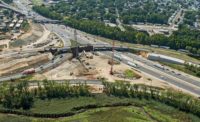

New York
Worker Deaths Decline, But Injuries Increase
Construction-related fatalities in New York City dropped last year, but the number of accidents and injuries rose, says Thomas Fariello, acting commissioner of the city's Dept. of Buildings. The agency also says it issued 1,890 construction permits for new buildings in 2013, a 29.3% increase over the prior year.
Three workers died in 2013—which DOB attributes to inadequate fall protection at the jobsite—compared with eight in 2012. One death occurred in January 2013, when a worker fell while a steel beam was being installed at a site. To improve safety, DOB recommends that pretask planning is done prior to steel beam erection.
Non-fatal construction-related accidents climbed 5.7% last year to 186, while the number of injuries rose 4.3% to 195. Fariello says the increases are due to a rise in accident reporting by industry members.
DOB says it issued 5,812 full and partial stop-work orders in response to unsafe conditions, including those following the three fatalities. Fariello credits the agency's industry outreach on worksite safety and its enforcement efforts for the decline in fatalities. "These accidents should serve as a reminder that we need to keep up the pressure when it comes to safety," he said in a statement.
Already in 2014, there have been several construction-related injuries in the tristate region. These include eight workers hospitalized in late February in the collapse of a three-story house in Brooklyn that was under construction.
New York
Study: $47B Tab to Fix City's Aging Infrastructure
Manhattan-based think tank Center for an Urban Future says it would cost $47 billion during the next four to five years to bring New York City infrastructure to a state of good repair, a tab that the group urges city, state and federal officials to spend.
The lion's share of that investment should go toward repair and modernization of existing assets and encompass work that has little to do with Superstorm Sandy and storm preparedness, the group says in its recently released report: "Caution Ahead: Overdue Investments for New York's Aging Infrastructure."
Funded by RBC Capital Markets, Canada's largest bank, and the Association for a Better New York, a civic advocacy group, the study examines numerous types of infrastructure, ranging from sewage pipes and subways to natural gas service lines, and the problems that arise when structures are already well past their life cycles.
For example, it points to more than 1,000 miles of city water mains that are more than 100 years old and vulnerable to frequent and disruptive breaks. More than 160 city bridges are more than 100 years old, with 47 deemed structurally deficient and fracture-critical, it says.
"Too much of the city's essential infrastructure remains stuck in the 20th century, a problem for a city positioning itself to compete with other global cities in today's 21st century economy," the report says.

